
The Imitation Game. Top reps tested, plus all you needto knowto buy or build your own. A multi-million pound grid of 1960s sports cars? No, but they don’t skimp on quality. We head to Goodwood to try four of the best replicas, and explain how to do it yourself. Photography Tony Baker.
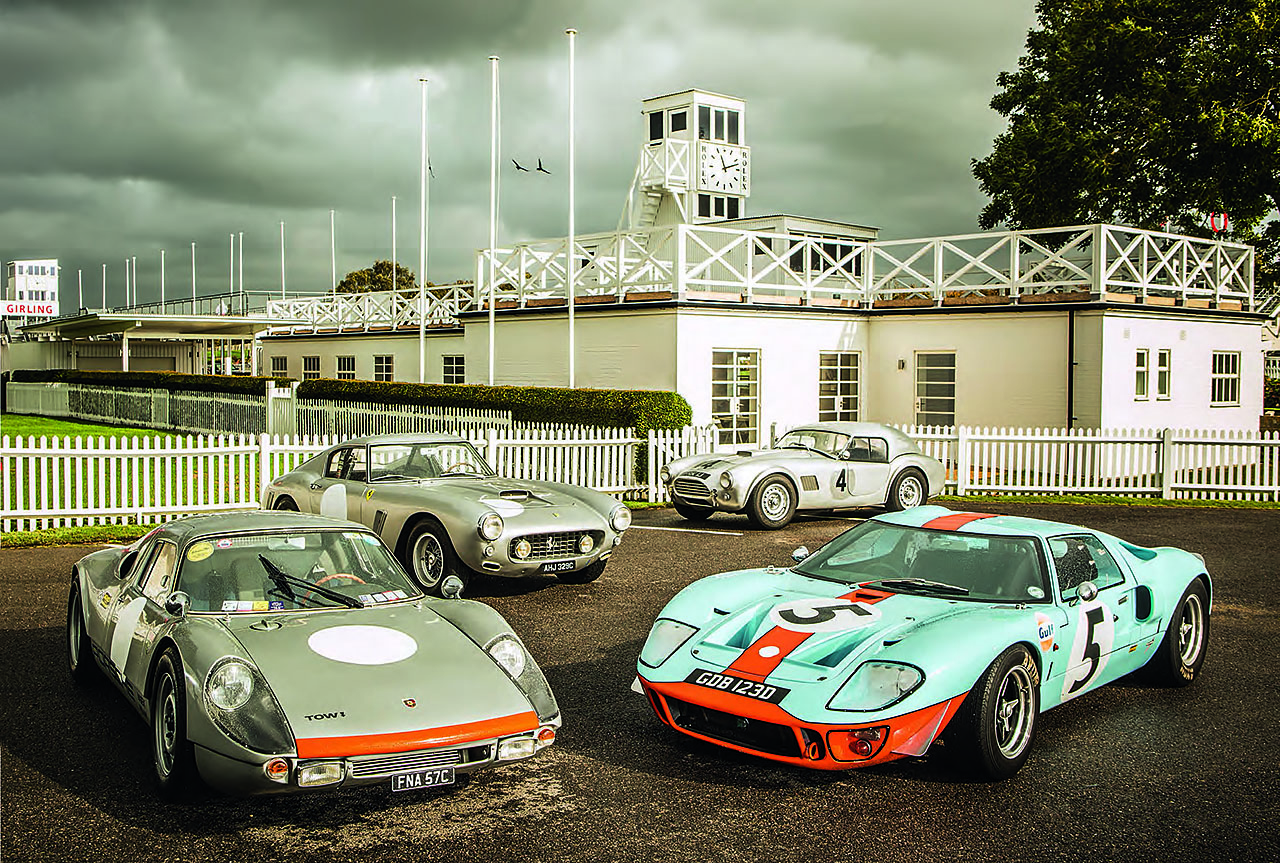
HAWK 289 LE MANS
The Cobra offered one of the most visceral experiences of any road car when it first appeared in the early 1960s, proving to be a much greater car than the sum of its parts. So it is with Hawk’s 289 Le Mans replica, which is based on the two Cobras that were campaigned at the 1963 Le Mans 24 Hours.
Structurally, the 289 Le Mans is identical to those originals, even sharing the same 3in ladder-frame design, as Martyn Cavey explains: “The chassis in our early models, such as this one, were powder-coated, not painted as on the originals. Aside from that, the whole construction of the car is identical. All of the wishbones, running gear, brakes, calipers, discs, hubs and springs – everything – is exactly the same as on an original example.”
The replica also apes the Le Mans cars’ hardtop, which was fitted in a bid to improve the Cobra’s top speed – it was regularly getting beaten by the more slippery Ferrari 250GTO in top-flight competition. Wider wheelarches, FIA bonnet scoop and roof-mounted fuel-filler cap are also reproduced to perfection – while the cost-effective alloy wheels of our test car perfectly evoke the Dunlop rims on which the works Cobras ran at Le Mans in 1963.
The shell, which is made from hand-beaten aluminium, is also as per an original Cobra – and the craftsmanship is clear to see. The brushed bodywork matches the attractive proportions of the original slab-sided 289, while the tell-tale lines where individual panels have been joined to form the curvature of the hardtop are easily visible from the confines of the cabin.
Like the chassis, the bodywork is crafted in Poland before being assembled in Sussex: “I built all of the aluminium cars,” explains Cavey. “On average, each Cobra takes around 300 hours to get up and running – excluding paint – to the point where you could then drive it down the road for an MoT test.”
The choice of powerplant is largely dependent on whether you plan to cruise boulevards or line up on a starting grid. The venerable Windsor crate motor (as fitted to ‘our’ car) costs around £5000 and at about 330bhp is more than powerful enough for a spirited drive, but a competitive engine will cost more – inflate that price by a factor of six if you’d like to go racing. A fully completed FIA example, such as this Le Mans version, would cost around £90,000. In comparison, a glassfibre car – which Hawk also produces – is available for less than half that price, at around £40,000.
If your budget doesn’t stretch to a turn-key solution, there’s always the option to build your Cobra at home, and it isn’t as tricky – or as expensive – as you might think. Each Hawk 289 body and chassis kit costs around £8000 and is supplied with all of the bulkheads, inner wheelarches, boot and cockpit floors already bonded into position, with the body aligned and bolted to the chassis. In addition, the doors, bonnet and bootlid are pre-fitted to the structure – saving countless hours crouched in front of your car, squinting with one eye closed and slowly losing the will to live.
Though externally similar, the glassfibre car varies considerably from the aluminium-bodied version. The chassis, for example, is constructed from thicker 3½in tubular steel, which adds rigidity, with modifications to allow for the fitting of MGB running gear and rear axle. It’s also bracketed to accept Jaguar independent rear suspension, while engine options are varied and numerous. Kits are available for the MGB’s 1.8-litre ‘four’ and 2.5-litre Triumph straightsix, as well as the more popular Rover V8 and Ford small-block V8 options.
But while the glassfibre cars offer fantastic ease of build and value for money, it’s the 1963 replica that really excites. Is it worth the extra money? For me, the answer becomes clear as soon as my eyes fall on the Cobra sitting in a quiet corner of the Goodwood circuit, its brushed aluminium bodywork unnaturally bright against a foreboding and overcast sky: yes. Climbing aboard can be a bit of a challenge: the door aperture seems unfeasibly small, and the cabin is dominated by the rollcage. A reassuring thud accompanies the door’s closing, which is a marvel considering the thin gauge of aluminium from which it’s constructed. Once in a comfortable driving position, the cage again seems spiteful, very nearly – yet not quite – fouling the gearchange, just as in the original cars.
Once tied down by the Luke harnesses, a quick turn of the key calls the V8 to action, the exhaust note reverberating around every nook of the thin aluminium shell: the hardtop definitely doesn’t detract from the aural experience of the roadster variant. The ball-topped shifter slots firmly into first, and is married to a pleasingly light clutch. Slowly swapping to second has the car rumbling along at tickover, taxiing into position behind the camera car.
Out on the circuit the Cobra sits beautifully alongside the GT40, GTS and short-wheelbase Ferrari during our photoshoot. But the surface is slick, so even in third gear the V8’s power is enough to provoke the rear wheels to lose traction. Today is not the day to test the limits of grip, nor my driving skill.
Later in the afternoon there’s an opportunity to assess the car in more everyday conditions away from the track, on the lanes surrounding Chichester. Driving on public roads is less troublesome than you might have imagined: the car’s proportions offer no notable challenges, even on narrow streets, while visibility is better than you would expect – though it is impeded slightly by the presence of the hardtop.
‘THE CHOICE OF POWERPLANT DEPENDS ON WHETHER YOU WANTTO CRUISE OR RACE’
The only issue comes in traffic, where the Cobra can get a little too warm for comfort. Those not dead-set on a true part-for-part copy could be tempted to fit an electric cooling fan. What strikes you most about the Cobra is its sheer usability. Despite its thumping V8 engine, the car is a delight to drive, with a straightforward ruggedness and forgiving gearbox that really flatter. It’s a car in which you could pick up your son or daughter from swimming, collect a few groceries and still be home in enough time to get your FIA papers in order – all for less than a tenth of the cost of an original. You can’t say fairer than that. Greg MacLeman.

Clockwise, from main: 289 looks superb in ‘bare’ finish; small-block Ford V8; quick-release filler cap; gearlever apes original; alloy wheels.
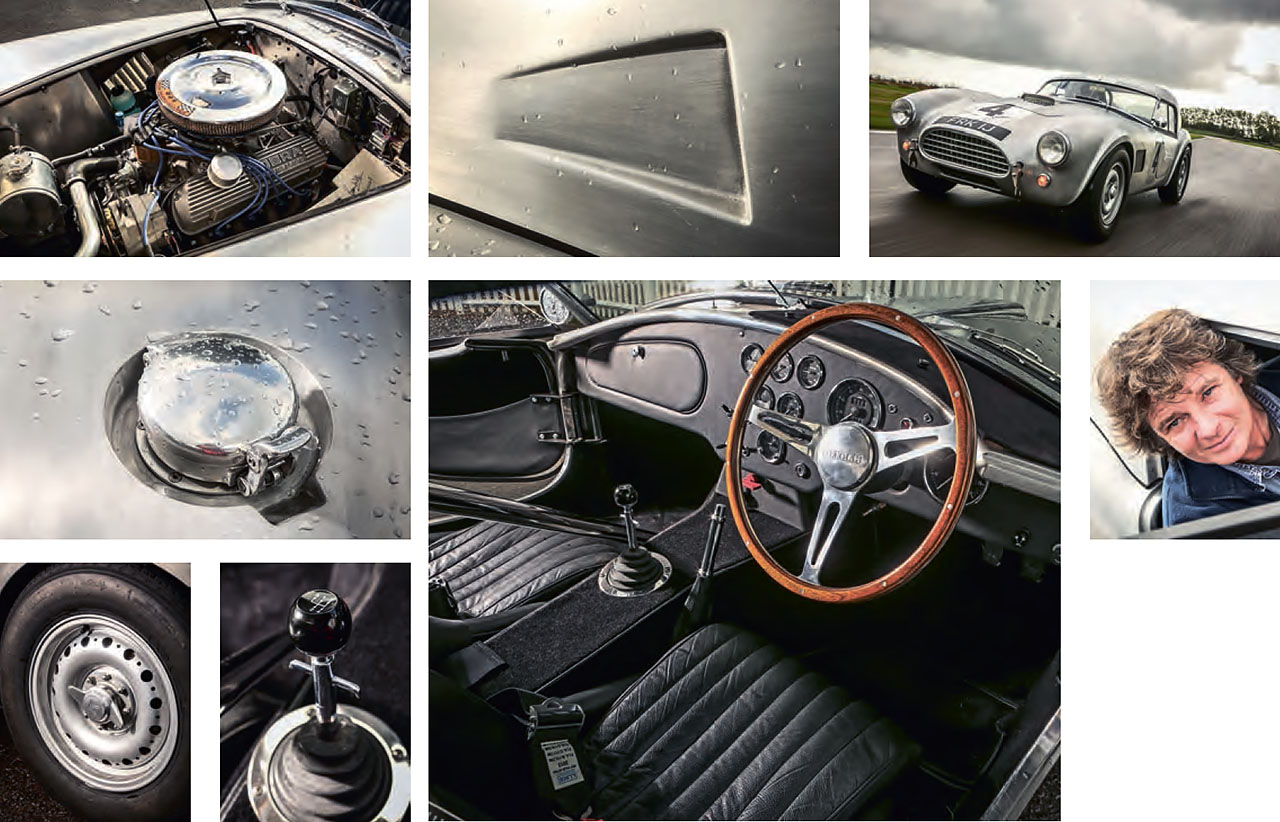
Clockwise, from left: rollcage makes life a little bit claustrophobic in the authentic cabin; the bodywork is painstakingly crafted in Poland before final assembly takes place in the UK; huge power means that it’s easy to provoke wheelspin on a damp track; Hawk’s Cavey.
Law of the land
If you start building a replica today, it is vital that you follow the correct route, otherwise you could end up with a dream car you can’t legally use. Phil Cottrell of Classic Jaguar Replicas explains that there are two options for keeping things square with the DVLA.
“You have to go through the Individual Car Approval (IVA) scheme,” he says. “If you can prove that you are using enough donor parts from an older vehicle then you can go down the age-related route. Alternatively, you have to register it as a new build.”
Cottrell tends to use an XJ6 as the basis for a C-type replica and, because several of the main components are retained, he can put the car through IVA using the XJ6’s build date as a guide for the compliance regulations. “This means that the C-type doesn’t have to conform to modern emissions restrictions,” he explains. “Then an age-related registration number will be issued.”
If you don’t have enough components from one car in order to qualify, you will have to register it as a new build: “You then need to comply with a set of regulations specified at the time of registration, so you’ll need a catalytic converter in order to get it through the emissions test. The car will also have to meet 2015 MoT requirements.
“In either case, you will have to fit dualcircuit brakes, side repeaters, hazard lights, reversing lamp, foglight, a collapsible steering column and do away with ‘dangerous’ eared spinners on the wheels.”
So what approach does CJR take to make sure its builds pass testing? “We make things easier by fitting a ‘fly screen’ instead of an aeroscreen,” explains Cottrell. “If we fit a ’screen that you can look through, we have to fit demisters and wipers, but you look over a fly screen so those rules don’t apply!
“The headlights have to be higher than on an original C-type, but instead of changing the body we make the front suspension adjustable so that the height can be raised to meet the regulations. We also use non-eared spinners.” For more information, see the Kit Conversion section of the DVLA’s INF 26 leaflet. MP.
SOUTHERN GT GT40
One trip to the Le Mans Classic and a walk around the campsite would be more than enough to illustrate just how revered the Ford GT40 is and, by default, why it is still one of the most popular replicas. As with many recreations or continuations, cost is undoubtedly a key factor – a brief look at recent sale results shows exactly how far out of reach one of the 133 originals will be for most potential owners – at the time of writing, the last recorded auction price was £4.1million.
Since the 1960s, there have been a number of offerings for those who fancy a ‘GT40’ for some weekend fun, but it was a visit to a gathering at Brooklands one year that kicked things off for Glenn Mason.
“I’d been a fan of the GT40 since my school days,” he says, “so when I saw one in the metal, I started chatting to the owner and found out that it was a replica – I didn’t even realise you could get one!” But that chance encounter got him thinking and, after some research, he decided that he was going to build his own. Mason went out and bought a GT Developments chassis before looking at how he could turn it into the vision he had in his mind.
Following a visit to Southern GT in Southampton, however, he realised that everything he was looking to change on the GTD chassis had already been incorporated on the SGT version. He therefore dropped his original starting point in favour of this new-found alternative. So what was it about the SGT chassis that impressed so much? “This was always going to be a car destined for the track,” explains Mason. “The SGT spaceframe had been developed with effective geometry at the forefront and, with the modifications I required already being present, it made so much sense.”
At the point of ordering the chassis he had to choose a gearbox, and followed many others in specifying the unit from a Renault 21 Turbo. With the frame still under construction, a friend offered him a drive in his GT40, which was also fitted with the Renault ’box: “It was horrible.
The gearchange was appalling and I remember coasting back into the pits in neutral – I was convinced that if I tried to select a specific gear, I would end up in the wrong slot!”
He quickly got back on the phone to Southern GT and, following some slight alterations to allow for a different gearbox, he ended up with the Quaife ZFQ. That ’box is mated to an alloy-block 5.4-litre Ford V8, fitted with aluminium heads from US race engineering firm Brodix – the combination of which resulted in a recent dyno reading of just under 500bhp. The decision to opt for the Southern GT chassis also brought about other advantages. Not only were they happy to dispense copious amounts of advice, but they could also supply practically everything that Mason would need for his build – including the body.
In its original form, this was of glassfibre construction, but in time the rear shell would be replaced with a carbonfibre version in order to save some weight. The body also provided one of the most challenging parts of the project.
“Getting the doors to fit was incredibly timeconsuming” admits Mason. “They come as oversized units and you need to trim them down to size while making sure that the fit is correct on all apertures – including the roof.”
This isn’t a build that has scrimped on attention to detail, and Mason has been fastidious in trying to make it look and feel like the original item. One-piece 15in rims were chosen instead of the more common 17in options because they “look right”, and, with period-feel Avons out of production, it took considerable lobbying from Mason and fellow GT40 owners, as well as the Cobra clubs, to persuade the company to remanufacture suitable tyres.
A set of original GT40 doorhandles was a surprise find right at the beginning, and Mason has worked hard to source hard-to-come-by details such as the dashboard grille panel, originally from a Ford Zodiac.
All of these items have resulted in a replica that is arguably the next best thing to an original, and easing into the cabin provides that same special feeling as being behind the wheel of a Slough-built example. Taking time to survey the toggle switches (none of those nasty BL rocker versions here), you don’t bother adjusting the Jaguar Mk2 rear-view mirror because visibility is almost non-existent through the Plexiglas panel. Instead, you reach for the start button.
A definite prod then a blip of the pedal results in a growl that sends the hairs on the back of your neck standing to attention and confirms that this build is triggering all the right emotions. Although the small-block originally had Webers fitted, Mason has replaced those with an injection system from US-based Eight Stack. That may do away with some of the trademark pops and bangs at low revs, but the result is a smooth, controlled power delivery. And, as Mason is keen to point out, it means that the GT40 is more pleasant to drive away from the track. Out on the circuit, that injection makes it easier to keep things in check behind the camera car, but once the photography is done it’s time to open things up a little.
The acceleration pushes you back into the eyelet-studded seat, while the spaceframe chassis, steering and braking inspire confidence. The ZFQ ’box is a pleasure to use, too, with a positive change. Given the chance, I would gladly complete lap after lap, pushing the limits of Mason’s excellent interpretation a little more each time. It’s the best replica that I’ve driven. As you would expect, with a clear emphasis on performance and handling, this is a car that is used extensively on track. Mason and his partner Tammy regularly participate in track days and sprints. The car has had outings at Goodwood, Castle Combe, Donington Park, Brands Hatch, Angoulême, Spa and the Brighton Speed Trials. “I’ve spent a lot of time and money making it into a car that looks and feels right, as well as being what I want and need,” he says.
And his advice for anyone else who is considering building their own GT40? “Work out what it is you really want and then buy the best you can. Otherwise, you will end up spending more time and money trying to make the ‘wrong’ one right.” Martin Port.
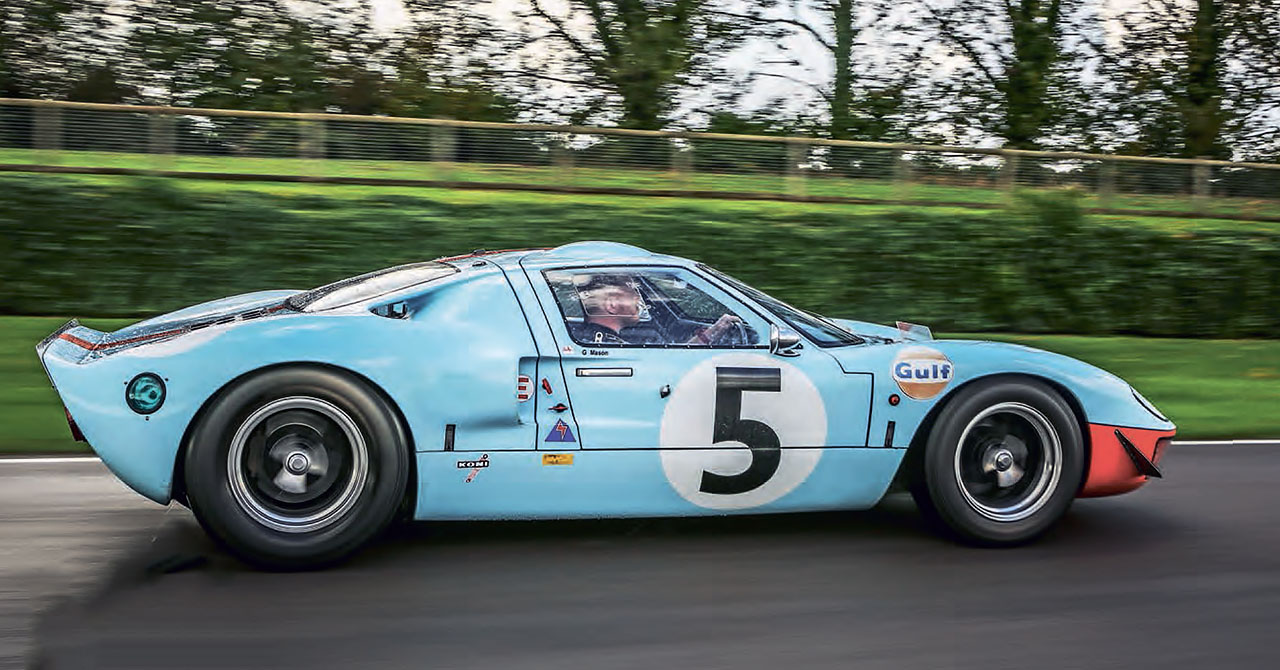
Clockwise, from left: fastidiously arranged cabin perfectly echoes the original; Southern GT focused on suspension geometry; blue Le Mansstyle marker light came from Lancaster bomber; proud owner Mason.
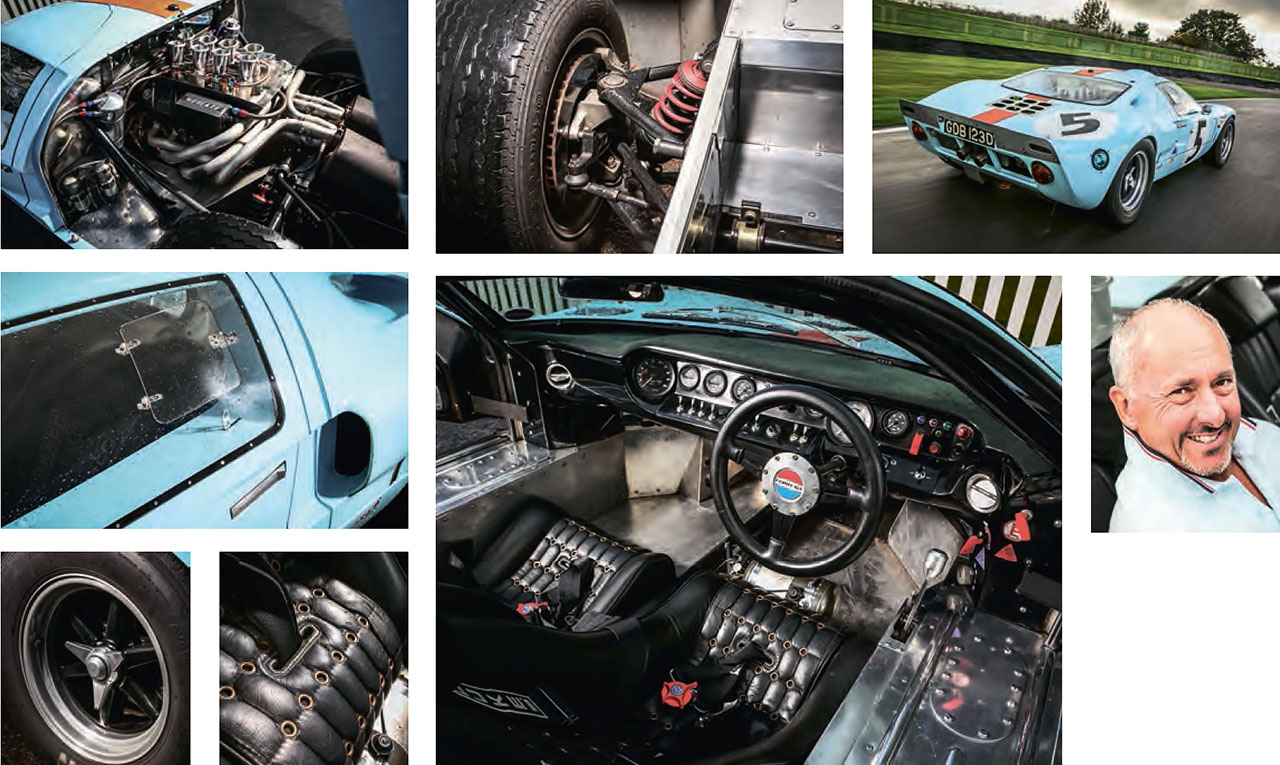
Clockwise, from main: Port living out his dream; Ford V8 gives almost 500bhp; authentic details and trim; Avon remade correct tyres.
“I’VE SPENT A LOT OF TIME AND MONEY TURNING IT INTO A CAR THAT LOOKS AND FEELS RIGHT”
Popular picks
HAWK HF2000/3000
The charismatic Lancia Stratos was an obvious candidate to receive the replica treatment. Hawk’s kits are available with a range of engines, from a 2-litre ‘four’ to a 3-litre Alfa V6 and even a Ferrari V8. You can specify a Stradale-style body (right) or the vivid Group 4 Alitalia livery. The most basic kit option includes everything you need to complete the rolling chassis.
EVANTA GT
This homage to the Aston DB4GT Zagato can be constructed around either a scratchbuilt, bespoke ladder-frame chassis, or converted from a DB7 platform. The latter is offered with a choice of the donor car’s straight-six or V12 powerplants.
WESTFIELD XI
Westfield began producing batches of its Lotus Eleven recreations as long ago as 1983. The little sports-racer uses a 1275cc A-series engine, with many other MG Midget or Austin-Healey Sprite components being required from a donor car. The Westfield kit, meanwhile, includes pretty much everything you need to produce a rolling chassis, with prices currently starting at £9999.
SUFFOLK C-TYPE
Jaguar’s famous sports-racer has inspired a raft of facsimiles, but few are as exacting as those from Suffolk. The body moulds were formed from a genuine example, the chassis is a direct copy of the original, and Jaguar XK engines are fitted. The C-types are sold fully built or as a kit.
CHESIL SPEEDSTER
The Porsche replica scene has long been thriving, and Chesil’s offerings are among the best known. The kits are based around Volkswagen Beetle donor cars, and are once again sold either fully built or part-finished. All of the components can be specified individually so there is almost endless scope for options. A complete ‘Porsche 356’ will cost you in the region of £30,000.
FERRARI 250GT SWB
David Meer’s only option if he wanted to own his dream car, the fabulous Ferrari 250GT SWB, was to build his own. “ Ever since I saw one driving up Teddington High Street in the 1980s, I’ve thought that it was the most beautiful thing,” he says. “Unfortunately they’ve always been out of my reach.
“From an early age I’ve enjoyed tinkering, and my engineer Dad always encouraged me. I built a beach buggy before I’d passed my driving test, and for me the Ferrari was just another kit – but with more expensive bits.”
Although the 250 SWB ownership ambition was never forgotten, Meer had no idea that replicas were being built until the advent of the internet opened up the prospect: “I made contact with Chris Lawrence [not the Morgan one] who was building GTOs in Norfolk, and he was very inspiring. He was a genius, and built copies – including SWBs and Californias – solo, virtually from scratch. After a visit to his workshop I was determined to start on my own.”
Meer couldn’t stretch to a 250GTE donor project, but snapped up a pair of beyond-repair 330s in California for £10k: “I sold one to Chris and started stripping the other to a bare chassis. While the engine was sent off to be rebuilt, a friend and I set about shortening the frame by 8in. Sadly, Chris died during my lengthy build, but his wife very kindly loaned me his drawings with strict instructions that no one else was to use them. Progress was slow because I did everything myself other than the engine. Mark Lyon and Kevin Jones at GTO Engineering were a fantastic help, even popping down to my garage, and later allowing me to visit their workshops. Amazingly they let me take millions of photos, and even sold me a genuine SWB rear-view mirror. It’s the only original part on the car.” The body remained a challenge until a replica skin turned up at Eurospares for £14k: “It was straight from Italy and the panels were all floppy. The quality wasn’t good and I had to remake much of it including the frame and inner panels. For three years I grafted away in my garage making window frames, seats and even doing the upholstery myself. Every time I saw a SWB at Goodwood, I’d be crawling all over it for reference. Race mechanics were always very helpful. All the time I was worried about how mine would finally look.”
Meer was convinced certain parts were going to be a problem, or require major expenditure: “I dreaded trying to find a front windscreen, which is key to successfully recreating the styling. Searching the internet one night I noted that the SWB was listed with Euroglass but automatically presumed it was a mistake listing. To my joy they reported a three-week delivery for just £400. The whole body was subsequently structured around it.”
Detail became an obsession, and Meer found himself frustrated at every stage: “I eventually managed to find a set of authentic 250GT dials in New York, and a set of Marchal headlights, which really set off the front.”
Evocative old photographs from the Tour de France were a constant inspiration, particularly shots of double winner Willy Mairesse: “He’s a bit of a hero, and I soon decided the car had to be silver as an homage to his 1960 Tour win. I loved that racy look with roundels and no bumpers.” In preparation for long trips down to the South of France, Meer decided to fit air-conditioning to improve his partner’s comfort, and an alternator conversion was carried out.
Meer has always been open about his replica’s origins: “For me driving a Ferrari isn’t enough. I wanted to immerse myself completely in my favourite, and building one was as close as I could get to Enzo and the brilliant Italians who built the originals. Cars are supposed to be fun, and those who get upset about replicas need to lie down.” The hands-on construction of the SWB was the most satisfying part for Meer: “I’m already thinking about the next project. It’s been on the road for two years, and I’ve had some memorable drives down to Goodwood and around local lanes. There’s nothing like taking it out early in the morning or on a beautiful evening. Changing up and down the gearbox with that fantastic exhaust note is a special feeling, but the nagging worry of the expense of an engine rebuild is always there.”
Meer now has his mind set on creating a 375MM: “Even though it took 10 years’ work, the task hasn’t put me off another project. I loved the creation of such a beautiful thing.” In December 2014, Meer decided to auction his SWB replica at Coys’ True Greats sale in London, where it was catalogued as a ‘1965 330GT Aluminium Berlinetta.’ Not surprisingly, the convincing copy created strong interest and, after determined bidding, it eventually cost the new owner £249,000. When you consider that a genuine steel-bodied 250 SWB is upwards of £4million, this 330GT ‘special’ now looks a bargain: “The project cost me less than £100,000 not including all my labour, but you couldn’t do it today with the values of 330GTs.” With that glorious exhaust bark, the SWB replica sounds the part when Meer arrives at Goodwood after a run down on very wet roads, the Pininfarina design splattered with muck. Copy or not, it’s a shape and sound that is always a joy to witness, and very few would have known it wasn’t the real deal as it rasped through Midhurst and blasted up Cocking Hill.
Out on the track, the impression is just as convincing – even if the controls don’t quite have the smooth, quality feel of the original. Behind the broad Nardi wheel, enjoying the evocative view down the bonnet through Madgwick and St Mary’s, it is easy to convince yourself that this was what Stirling Moss and Mike Parkes experienced in the 1960s. The heavy steering and cramped footwell slightly spoil the impression, but double-declutching through its classic Ferrari gate feels and sounds authentic. With finer tuning and continued investment, Meer’s creation could one day be running in historic racing if values of originals continue to rocket. This faithful replica is still a ’60s Ferrari at heart, but not as it left the factory. Pre-war Bentley, Riley and Talbot enthusiasts have been creating similar projects with Le Mans-style conversions for years. Mick Walsh.
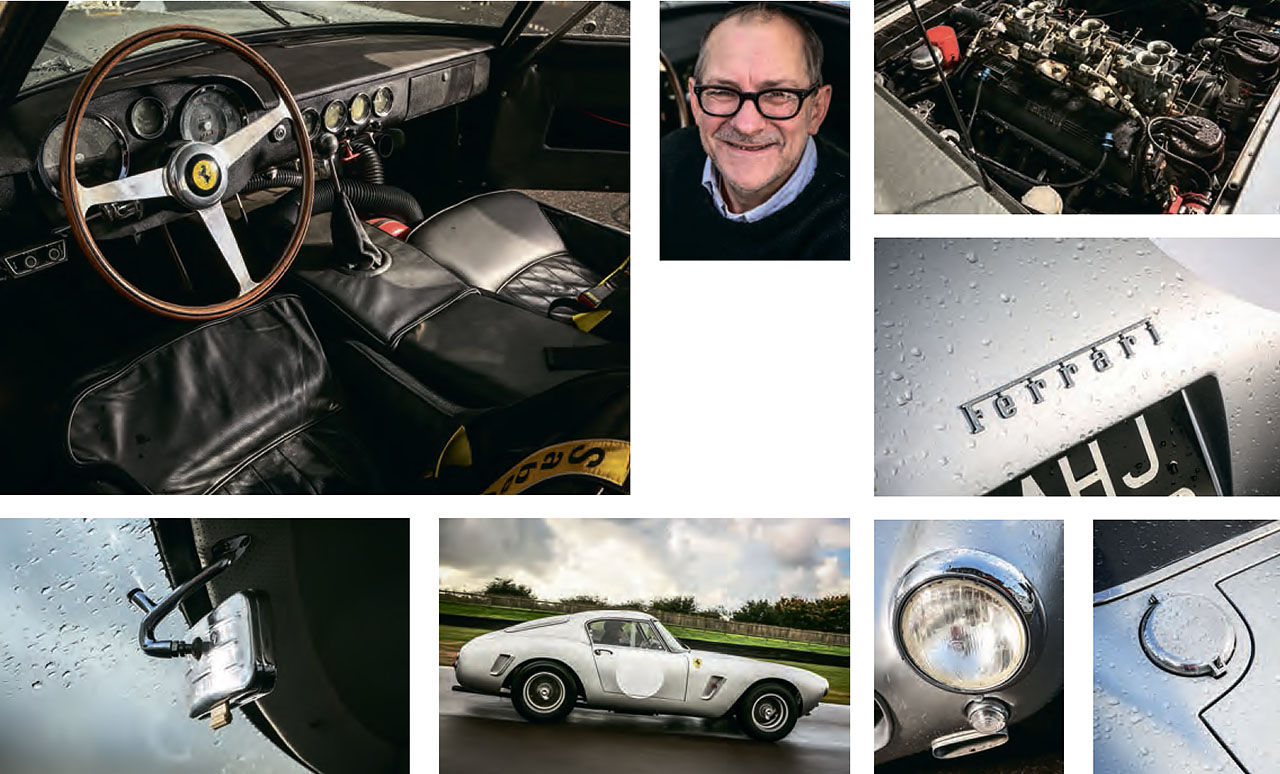
Clockwise, from below: Walsh explores the car’s straight-line performance; genuine SWB rear-view mirror; 250 instruments were finally tracked down in New York; Ferrari fan Meer now wants to build a 375MM recreation.

Meer had to remake much of the body to bring it up to scratch. Below right: 330’s glorious V12; still a Ferrari at heart; neat filler cap; Marchal headlamps.
How the market views recreations
When quality replicas come on the market, particularly a car with known history among marque connoisseurs, they always sell strongly. A superb Lynx XKSS (right, top) previously owned by Dick Skipworth, for example, blitzed its estimate at £384,540 when it was auctioned by Bonhams at the 2014 Goodwood Revival. Respected specialists such as Lynx have always commanded a premium. Britain has a long tradition of ‘cottage industry’ replica builders such as Chris Lawrence, Peter Shaw, Bill Monk and Peter Jaye. Any car made by such talented artisans is highly desirable.
Replicas, particularly those judged by the FIA as ‘toolroom copies,’ have also proved a good investment in recent years. Back in 2005, a Jaye-built Jaguar C-type could be had for £75k, but today they’ll make around £200k.
“When buying, it’s important to check who constructed the car,” says Roy Kent of The Old Racing Car Company. “Unless you’re an expert, it’s always worth getting a specialist to judge its accuracy and how well it’s engineered.” Buying a sorted, finished replica is the most economical route. Just such a bargain was a 1936-style Invicta S-type Low Chassis ‘continuation’ car (right, bottom) sold by Coys last December for £176k. Built by Mike Bristow of the Invicta Car Company, it incorporated many original parts around a new chassis and couldn’t be built today for that price.
The pre-war market for specials or ‘bitzas’ is a different culture, with the Vintage Sports-Car Club governing ‘new’ cars with its ‘three out of five’ rule covering major components, while the Bugatti Owners’ Club identifies replicas with its own BOC chassis series.
The market for copies with no donor-car base, such as Pur Sang Bugattis, has cooled due to the present crisis with the DVLA (see our site). The underpinnings of a replica are key to its value. Had ‘our’ SWB been based on a 250GTE rather than a 330GT, it would be worth at least another £100k. Such authenticity makes the replica eligible for many more events. “Modern historic provenance is an increasing factor in a replica’s value,” says Kent. The lookalike market is also strong, says Mark Harrison of Total Headturners, which often has 20-plus Cobras in stock: “Enthusiasts are more knowledgeable now and want the best manufacturers. The main demand is for the 427 shape, and a top AK will make £50,000. They are easier to drive, cheap to run, and great fun.”
MARTIN & WALKER 904
Porsche aficionado Andy Boyle has owned “about 12” early 911s over the years, plus a 912 and a 914-6 replica, so it was no surprise that he turned his hand to reproducing one of Stuttgart’s prettiest 1960s competition cars. This Porsche 904GTS was by no means his first build, though, having previously made clones of Jaguar’s C-type and D-type, plus a Dino-engined Stratos. “It took me four years,” he explains, “but a lot of that time was taken up with trying to track down certain parts. The rear reflectors were the hardest to find. I travelled to Rennsport Reunion in Monterey, California so that I could check out several original cars, but finally sourced some new ones via German eBay. The rear lights are from a Saab Sonett, and the door buttons are Simca 1000 – I even managed to get hold of an original 904 fuel-filler cap. I sourced the SEV Marchal headlamps at a Bristol autojumble, and they were only £5 each!
“After approaching numerous companies in the UK and Europe to make me a set of bi-metallic wheels without any success, I found someone in Australia who fabricated a set by cutting the centres out of my 1965-dated steels and riveting them into new aluminium rims. “One of my main concerns was that I didn’t want it to look brand new – I wanted it to look like a well-used original. The plastic screws that secure the Perspex headlamp fairings and the fixed part of the door windows, for example, are still made and identical to those used by Porsche in the mid-1960s. They look too white when they’re new, though. After poor results trying to ‘age’ them using black coffee and various woodstains, I eventually achieved the result I wanted by submerging them overnight in curry paste.” The starting point had been one of Martin & Walker’s 904GTS bodies and chassis. The company also makes 550 Spyder, Speedster and 356 replicas, with all three being available as kits or fully built. The 904GTS, however, is supplied only as a ‘turn-key vehicle’ made to the customer’s specification, either with or without an engine and transmission.
Boyle was able to be a bit more hands-on with his project: “I’d known Barrie Martin for many years so he allowed me to source a lot of the parts myself. I ended up making a few modifications that he has since incorporated into subsequent builds – the column switches, for example, which came from an early VW bus.
“Original 904 windscreen rubbers had a white ‘band’ around them, and although I found one in the USA it was $900. My solution was to buy some white latex strips from – of all places – a fetish shop, and glue them to the ’screen rubber. When I told the seller what I planned to use the latex for, he explained that it would age and go yellow, but that was exactly what I wanted. “The Martin & Walker chassis is a direct copy of the Porsche’s ladder frame – others use a semispaceframe, which is a surefire giveaway (Stuttgart moved to a spaceframe for the 904’s replacement, the Carrera 6). The suspension is as per the original, too.”
That means an independent set-up all round, with double wishbones up front plus coil springs and an anti-roll bar. At the back, there are reversed upper wishbones, lower links and radius arms. Disc brakes are fitted at all four corners, while the gearbox was a freshly built close-ratio Type 914 that Boyle sourced in the USA. The ratios were chosen specifically to match the engine’s power characteristics, and there’s a 904 mainshaft that allows first gear to be changed, too.
Most original 904s were built to the specification with which the car was introduced at the end of 1963, which meant that they were powered by an air-cooled, quad-cam, 1966cc flat-four. Instead of following that route, however, Boyle has taken inspiration from the many original cars that have subsequently been converted to a flat-six, so he fitted a 220bhp, 2.5-litre, short-stroke twin-plug 911 powerplant that he had left over from a previous 911R replica. It’s a superb engine, with a ‘cammy’ nature that gives a definite step in power as the revs rise. It’s loud, too. Boyle normally runs it on open megaphones, but has fitted ‘street’ pipes in deference to Goodwood’s noise limits. Even so, the six-cylinder bark reverberates evocatively around the cabin.
You sit very low behind a wood-rimmed wheel, held in place by a period-style four-point harness. As you’d expect from someone as fastidious as Boyle, the instruments look just right. Straight ahead lies the rev counter, the red zone beginning at 6500rpm, with the speedometer to the left and readouts for oil temperature and pressure plus fuel level in a dial to the right. On the soaking-wet lanes around Goodwood, the little Porsche keenly darts around. The rackand- pinion steering is ultra-sharp – operating through 185/70 R15 front tyres – the ride firm, and the acceleration strong. It feels every inch the period road-racer – exciting, quick and noisy. Certainly there is nothing here that easily breaks your suspension of disbelief, the fantasy that you are aboard a genuine 904 tackling one of the great road circuits. Only the slightly woolly change from the gearbox – which is easily wrong-slotted if you’re not firm with it – detracts from the driving experience, but Boyle later discovered that one of the grub screws in the linkage had worked loose.
Once he’d finished the car, which he estimates cost him £70,000, Boyle certainly wasn’t shy about using it. This is no pampered toy. “I’ve covered about 4500 miles in it,” he says, “which includes a trip to Scotland and one to the Porsche factory, where some of the guys thought it was original when they first saw it! The appeal of a 904 over a 550 Spyder or 718 RSK is the fact that it can be realistically used on the road – there’s a surprising amount of stowage space. “It gets a great reaction everywhere, though, and I just got a buzz out of the build process. I think that the 904 is probably the best-looking car that Porsche ever built – plus I like to be different and drive something whereby you’re unlikely to meet another one on the road. “To me, the whole point of building a replica – apart from the looks – is to experience the way it drove ‘back in the day’, warts and all. My advice would be to do plenty of research and build it as close to original as is realistically and financially possible.” James Page.
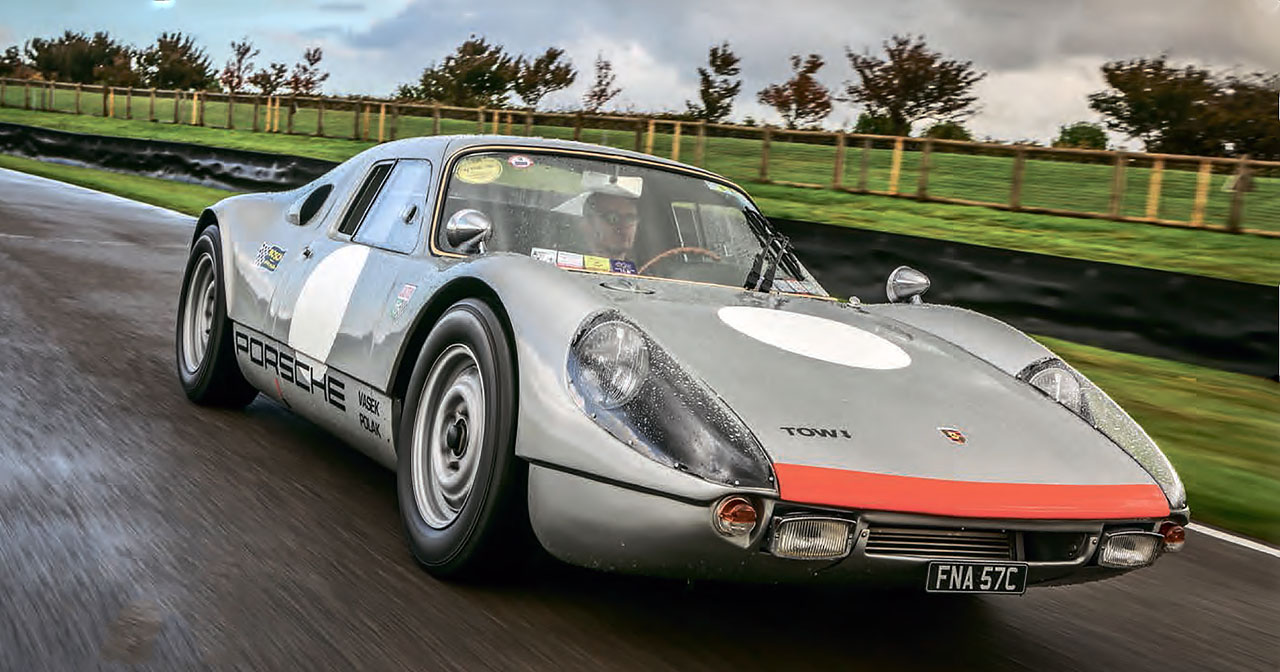
Gorgeous shape is well replicated. Below right: flat-six from 911; huge fuel tank; sliding windows; Boyle also has a set of bi-metallic wheels.
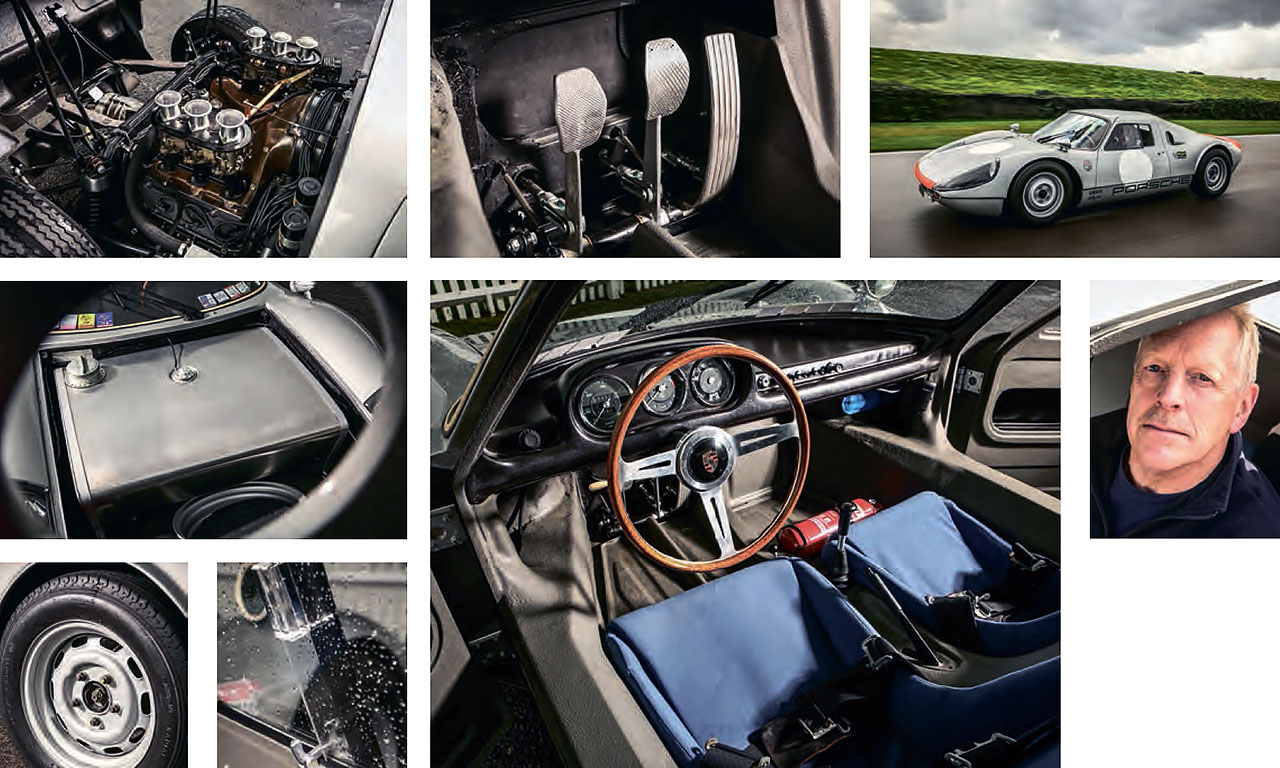
Clockwise, from left: bare glassfibre tub is fully visible in sparse cockpit; neat pedal-box; the 904 drives superbly, with a wonderful ‘crackle’ from the flat-six; Boyle went to great lengths to get the car that he always wanted.
‘THERE IS NOTHING HERE TO BREAK THE FANTASY THAT YOU ARE ABOARD A GENUINE PORSCHE’
The verdict
The extremely high quality of the four featured replicas reflects the dedication and skill of those who put them together.
They genuinely conjure the real thing to a remarkable degree, and while that sort of accuracy comes at a price – not long after our photoshoot, Boyle’s 904GTS sold at auction for £146,250 – it begins to look a lot more reasonable when compared to the value (and availability) of a genuine car. Building a replica is a very personal project, but the advantage of working closely with an established specialist is that the process of making it road-legal and registering it should be much smoother. Some enthusiasts have had problems buying and selling replicas of pre-war cars that were built from scratch around a new chassis. Four years ago, the DVLA was tipped off about a Pur Sang Type 35 that had an age-related number. When the car was later sold, the V5 was withheld and the new owner lost its registration. As a result, the dealer had to take the car back.
A few such cases have been resolved by owners agreeing to pay Vehicle Excise Duty relating to the year of manufacture, and putting the replica through the IVA test. With regards to registering new-build replicas, a DVLA spokesperson said to Drive-MY: “The vehicle will be allocated a current registration number and will be taxed in the same way as modern vehicles. Licensing it in the historic tax class, or being issued with a manufacture date/ registration number based on the vehicle it is replicating is not permitted.”
The key statement from the DVLA is this: “Provided a vehicle is correctly registered, there should be no issues for subsequent keepers.” That is what to bear in mind if you are considering buying a completed car. Don’t make the mistake of turning your nose up at anything that isn’t the genuine article. You’d be surprised at just how easy it is to be seduced by the noise, looks and performance of the best recreations. JP.
{CONTENTPOLL [“id”: 17]}





